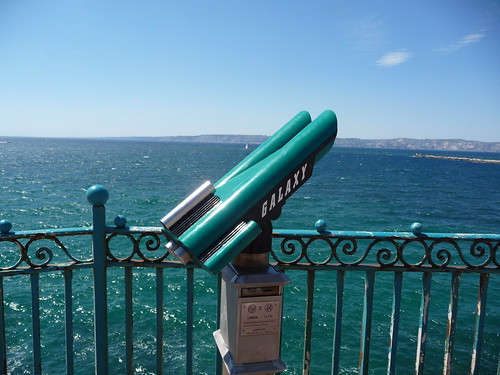Posted: June 28th, 2010 | No Comments »
In a week I will be in Marseilles, France to attend the Lift France 10 Conference that will focus on the interplay between network technologies and the future of manufacturing, learning, shaping cities and public policy. As usual the conference will aim at looking at the implications, the extend of the impact, the limitations, in other words in trying to grasp its full potential of technological and social evolutions.
I will contribute to the discussions with talk in the “Making sense of the world through shared data” them in the section “The New Science of Data”. My discourse will particularly aim at illustrating the exploitation of network data beyond their visualizations (see What Can Be Gained From This Data? and Below the Tip of the Urban Data Iceberg) with new types of research processes (see The Kind of Researcher I Am, The Rise of the Data Scientist and What is Data Science?) that lead to new opportunities to develop innovative services and solutions (see my most recent Lift Lab talk, Neighborhood Metrics, Detecting air travel to survey passengers on a worldwide scale and When a Real-Estate Platform Becomes an Urban Actor) with their potential potholes (see The Potholes in the Urban Information Landscape, The “Quants”, their Normalizations and their Abstractions, and Big Data: The Necessity of Mixed Methods) and ethical issues (see The Application and Management of Personal Electronic Information). Well, in other words, the summary goes like this:
Network data as material to shape urban strategies
Our constant interactions with network infrastructures generate data that aliment the integral function of services we use in our daily lives, for instance, when making a phone call, when withdrawing money, when using public transports or unlocking a Vélib bike. The accumulation of this massive amount of data constitute empirical and longitudinal evidences that help manage cities, their events, their mobility infrastructures and their buildings. As part of a new science of data, a blend of software engineers, statisticians, physicists, researchers, entrepreneurs and designers are working on processes that generate value from large amount of complex datasets with the prerequisite to protect individuals right to privacy. In this talk, I will provide examples on the exploitation of network data as material to measure occupancy levels and flows of crowds. With the capture of the pulse of space and the analysis of core samples it is possible to define indicators that help evaluate and shape the strategies of the different actors of the city (city councils, transportation companies, urban service providers, city planners and decision makers).
This year’s Lift France should be great. Besides enjoying France’s oldest and potential most futuristic city, Marseilles, I look forward to engaging with Matt Cottam, Stefana Broadbent, Manuel Lima, and many others.

Yet another an apparatus for capturing other points of View: Marseilles’ GALAXY coin-operated binoculars.
Why do I blog this: A presentation at Lift is always an excellent opportunity to reframe and strengthen my discourse and formalize my approach.
Posted: June 24th, 2010 | No Comments »
Intriguing metrics in relation to our investigation on identifying and measuring urban design qualities: the JaneScore measures the features that make for a “healthy urban neighborhood”, as articulated by Jane Jacobs. Based on Matt Lerner’s Walkscore who works with Liz Dunn at the Preservation Green Lab, it focuses on capturing the diversity of a street. In McNeighborhood Dan Bertolet describes the key variable:
The key attribute is diversity. In my interpretation, the JaneScore would focus on measuring diversity in a wide range of elements, such as building width, height, condition, style, and age; commercial space use, size, and rent; housing unit type, cost, and tenant demographics. Metrics to rate the vitality of street life would help round out the score.
Jonathan Hiskes highlights the potentials of this metrics in Measuring neighborhood diversity and liveliness with ‘JaneScore’
Building JaneScore maps sounds more difficult than building Walk Score, which draws from Google data. But it would help separate gentrified neighborhoods from economically varied ones. It would separate squeaky clean new neighborhoods from more eclectic historic ones. If JaneScore gets built out, it could yield heaps of information about the various flavors of urban living, which has great potential (see also Walkability Generates Real Value) to be sustainable living.
Why do I blog this: Data are at the source of these new metrics to define streets and neighborhoods. Both Walkscore and JaneScore rely on the static geographic, building, parcel, and demographic information. We are curious in coupling dynamic data and qualitative observations to the definition of these kind of neighborhood metrics (see Exploiting the Bluetooth Spectrum as Material for Space Management Strategies).

The hardly measurable diversity and vitality of a street. Photo courtesy of Nicolas Nova.
Posted: June 7th, 2010 | No Comments »
MIT SENSEable City Lab‘s urban demos and beautiful visualizations have often overshadowed the research works produced behind the scene (see Below the Tip of the Urban Data Iceberg). The Network&Society project aims at presenting the lab’s different research agendas for understanding cities with investigation on urban traces, visualization tools, eigenplaces, public transportation, digital footprinting and urban gravity.
This constant stream of 0s and 1s allows unprecedented research opportunities. Through phone calls we can see cities making bold ‘handshakes’ during business hours, and then becoming introverted during the evening. With SMS texts, we capture crowds cheering and sharing their emotional highs in special events. These digital traces also reveal the migratory magnetism of coastal city hotspots and the drudgery of a gridlocked commute.
The ‘Network & Society’ project at the MIT Senseable City Lab employs these large-scale digital datasets to explore physical mobility, social networks and urban places.

Visualization of mobile phone users locations, points of interest and events in Boston, USA
Why do I blog this: Demos and beautiful visualizations are part of the practice of data science. But they should not overshadow the many research outcomes from the experience and data generated during these urban demos.




